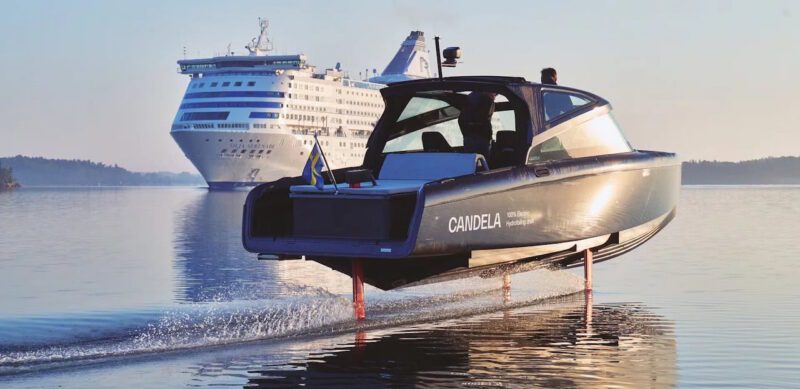An all-electric hydrofoiling boat from Swedish company Candela has set two new world records by travelling between Stockholm and the Finnish autonomous region of Åland, marking the first time an electric boat has crossed the Baltic Sea.
Candela, which has developed a range of electric hydrofoil boats and ships, wanted to demonstrate that “that zero-emission sea travel is not only possible today, but that foiling electric ships and boats are so much cheaper to operate than fossil-fuelled vessels.”
The record-breaking journey was undertaken in the Candela C-8, a €330,000 ($A544,500) leisure craft, equipped with a battery from technology partner Polestar.
The journey covered 150 nautical miles from the port of Frihamn in Stockholm, Sweden, to Mariehamn, the capital and largest town of the Åland Islands, an autonomous region of Finland, with a charging stop in Kapellskär.
While charging along the trip was made mostly with existing charging infrastructure, a 40kW Kempower Movable Charger was needed in Kapellskär.
Leaving from Frihamn at 6am, the Candela C-8 made it to Mariehamn by lunchtime, and returned to Frihamn the same day.
YouTube: https://www.youtube.com/watch?v=6hFoRF_Q0CA
“The disadvantage of electric boats has been their short range, due to traditional boat hulls consuming so much energy,” said Gustav Hasselskog, the company’s CEO and founder.
“With our hydrofoil technology, we combine high speed and range, but you get so many other benefits. Flying over the Åland Sea in total silence and without slamming was absolutely magical.”
A gasoline-powered chase boat of similar size accompanied the Candela C-8 on the journey and had to be refuelled for a cost of €750, or around $A1,230. For comparison, the Candela C-8 consumed 213 kWh of electricity, at a cost of about €40-50 (around $A66-83).
“We actually had range anxiety, but not for the Candela,” said Gustav Hasselskog.
“The irony is that the photographer’s gasoline-powered chase boat had to refuel six times during the trip, while we only charged three times.
“We’re talking about 95% lower operating costs,” concluded Hasselskog. “This is a revolution that makes waterborne transöport competitive with land transport in terms of costs, which we will now demonstrate in public transport in Stockholm.”
Joshua S. Hill is a Melbourne-based journalist who has been writing about climate change, clean technology, and electric vehicles for over 15 years. He has been reporting on electric vehicles and clean technologies for Renew Economy and The Driven since 2012. His preferred mode of transport is his feet.

